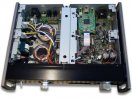Why would this be a problem for transformer based PSU's ?
There are E-I transformers, toroidial, R core, well separated bobbins, even foil screened bobbins etc. All of these have a different capacitive coupling for common mode and even differential mode 'crap'. And even then it is the signal routing/PCB design that determines the most what gremlins could possibly make it into the audio path, if they get there.
The thing is, torodial transformers are rarely just with shields. That is an axception, though it is a very efficient way to halt the noise AND the DC, if giving the core a bit headrrom, already in the transformer. The PCB is very good way also halt the noise. But there are commonly some disturbing flaws in the execution of the PCB's;
I/O's are not decoupled so in almost any ofthe designs I have scrutinized, interconnects shield noise is landed right on to the PCB instead of grounded to chassis. The stray infects the so delicate 0 volt ref voltage to numerous IC's including the DAC chip. Do not take just my word for it, it is a friend of mine, studio technician, Master of Science educated, at least 40 years in the profession, who rebuild DAC's like dCS, but also cheaper versions like Topping D90SE, who claims that ground ref is is a design flaw in it self as are many other areas. The ground is then also challanged by the standard procedure of soldering e.g. pin1 but also shields in USB's, I2S UI, etc in the PCB. The PCB ground should not be used to land noise from cable shield in my opinion. So when decoupling, you should be able to trust the ground you decouple to., but you cannot. One thing so often overlooked is the use of filter and buffert electrolythic caps. They are in the analogue domain often soldered i pairs from the positive and negative to the ground, instaed of caring for the ground by having one twice the size directly between positive and negative only. The filter caps for purely decoupling is wired equally. Why? Some brands use local regulators some do not. In my opinion all voltage regulators should of top class with a few microvolts ripple if any, and locally, with a large buffer, zobel and decoupling almost at the same pin as it is designed to feed. Hifi grade el caps is a myth. The modern 105 degree offers in general better life expectancy and radically lowered internal losses for decoupling.
While studying various designs I stumbled across a TEAC DAC, that I personally found interesting as it took a grip of the dirty USB cable shield. It lands the USB port at separate pcb, hard coupled to chassis by a screw and just millimeters from the port, minimizing the lead reactans, the entire PCB is grounded to chassis. This is an example of a good design. Others in that DAC could be questioned in my opinion. Could not see, e.g. any signs of a grounded lead out from an electrostatic shield in the transformers.
I agree with all you say, that is how it is supposed to be, but when I see the actual designs, I see a component choices, designs and U/I's that do not support that, sorry.






